 Prussian Navy – Ironclad Ram 1866-1871
Prussian Navy – Ironclad Ram 1866-1871
Prinz Adalbert & Prussian Navy 1870. A new cycle opens with a Navy that had very small beginnings and a rocky history to say the least. To arrive to the present unified Bundesmarine, it’s historical core was found in the old Brandenburg fleet in the 16th-17th century, until the Kingdom and state of Prussia was created in 1701, leading to the creation of a new, small navy. The present subject is about its first capital ship, the armoured ram, Prinz Adalbert, sister ship of the Kotestsu built in Bordeaux for the Confederate Navy. The next articles would see the turret ironclad arminius and various broadside ironclads ordered to British and French yards, prior to the war of 1870 with France and creation of the Imperial Navy (Kaiserliches Marine). Built in a rush, her green wooden hull proved her undoing. She was heavily modified after delivery to Prussia in 1865, served only actively in 1866 and 1871. Became a guard ship in Hamburg during the Franco-Prussian War. Postwar her wooden was discovered badly rotten so she was removed from service in October 1871, stricken in May 1878, BU later that year. https://naval-encyclopedia.com/industrial-era/1870-fleets/prussia/sms-prinz-adalbert.php #prussiannavy #brandenburgfleet #ironclad #warof1870 #schleswigwar
Oririgns: A Confederate Ram
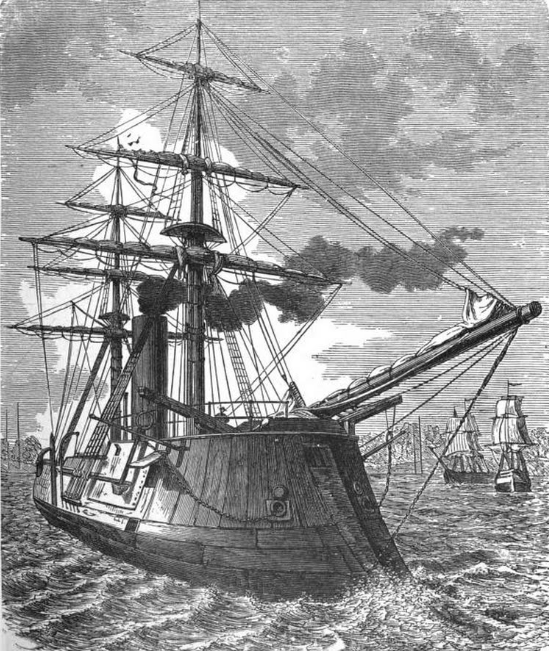
SMS Prinz Adalbert was an ironclad ram of the Prussian Navy and later Imperial fleet built in Bordeaux, France, in 1864. She was originally ordered together with another sister ship, more advanced and thus, named already CSS Stonewall Jackson. Both were ironclad rams wanted by the Confederate States Navy in order to break the Union blockade. Since France wanted to keep its neutrality in the American civil war, the ship was built under the cover name “Cheops” alongside her sister ship “Sphinx” at the French shipyard Arman Brothers in Bordeaux. The main cover story was that they were a gift to Egypt and Sultan Mohamed Saïd Pacha, in the wake of the construction of the Suez Canal which started in 1859 and was about to end as planned in 1869.
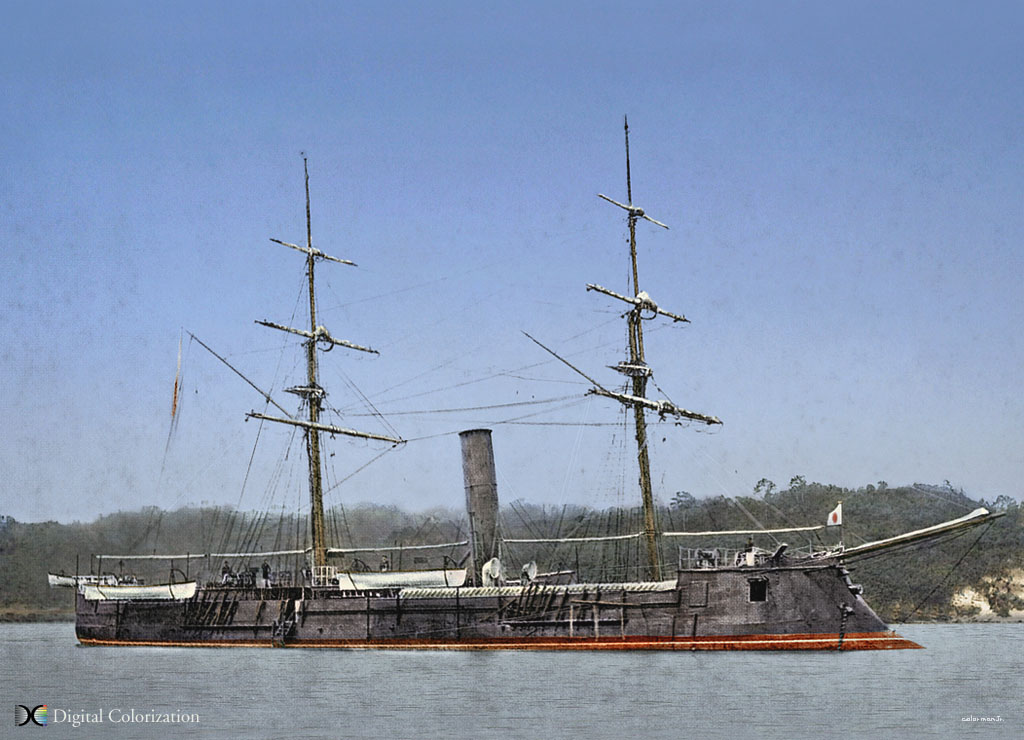
Her near sister ship, CSS Stonewall Jackson, Sphynx, Stærkodder, and finally Adzuma. She was different in armament.
The French emperor, Napoleon III eventually knew about the real customer and pressed the yard, Arman Brothers, to resell both ships to another navy immediately. In early 1864 the Second Schleswig War broke out between Prussia and Austrian alliance plus Denmark. Both the fledging Prussian Navy, which only had steam corvettes and frigates at the time, as well as her opposite the Danish fleet, sought to acquire available vessels in construction abroad. The Prussians interrogated their consul in Toulon (Southern France) to enquite about such warships constructions that could fit the bill, incuding one of these brand new ironclads.
Letters were exchanged after which Korvettenkapitän Ludwig von Henk, and Carl Elbertzhagen, chief Prussian naval engineer, member of the Admiralitätsrat (Admiralty Council) departed Prussia for France on 28 April to inspect Cheops on her slipway. The matter became burning hot as on 31 March, Denmark secured Sphinx. It was now urgent for Prussia to acquire Cheops, just to deprive Denmark for having her too. Arman Bros. thus sold her to Prussia on 25 May.
For the complicated story of Sphynx, which eventually was purchased by Japan and fought in the Boshin war, see the article on Kotetsu the future Adzuma, first capital ship of the IJN.
Delivery of Cheops was scheduled for 1 August. However when the Prussian naval engineer Guyot went to Bordeaux to supervise completion he determined there was no way the yard could deliver her in time. This was moreover a pressing matter as the Danish Navy had already received Sphinx, but Prussian agents in Denmark reported that they experienced significant problems with her. So rather than persisting, the Prussians cancelled the order. However soon after the Prussian Navy just received the two Augusta-class corvettes also from Arman Bros. and the admiralty praised them. So they soon reinstated deliveruy of Cheops (which new name was discussed) in January 1865.
The shipyard meanwhile persuaded Guyot it was possible to deliver her on 1 April. However by that time, the war was over (and won by Prussia). The French government however in between intervene, seeing the growing power of Prussia as a threat to the east, and initially refused to transfer the vessel. Arman’s reputation in Paris indeed was now severely darkened by its repeated attempts to obscure the actual intended buyer. After negociations with Paris (and perhaps a bribe) the delivery was eventually done in October 1865. Kapitänleutnant Archibald MacLean was placed in charge of the vessel for her transit to Prussia via the Skagerrak…
Design of the class
So after all this, what was worth this “capital ship” ? First off, she was designed for a precise task: Being a blockade runner. So her main weapon would not be her artillery, albeit heavy, but her ram. The idea was to use her unique forward gun to blast the broadside of an opponent to cause schock and commotion while she woud speed up to ramming speed. So after being renamed Prinz Adalbert, she had been designed as an armored ram with three guns: Her forward 21 cm (8.3 in) above the ram in a prow casemate, and two 17 cm (6.7 in) guns in armored turrets on both sides. Prince Adalbert of Prussia was an early proponent of Prussian naval power so this was seen from Berlin as a fitting choice.
However she was a mixed construction ironclad, with a wooden hull (the aquitaine region in which the yard resided was known for its immense forestry exploitations) covered with wrought armour. However the rush of the construction, first for the Confederate, then the Prussians, meant the wood had no time to dry and being ready for assembly and to last. Since in both case this was for an ongoing war, it was not seen such a problem. But for the long term, the wood was just still too green. As a result she ended poorly built and would have a very limited service career.
Hull and general design

Plan of the similar Sphynx
Prinz Adalbert was 50.48 meters (165 ft 7 in) long at the waterline, 56.96 m (186 ft 11 in) long overall. Her beam was 9.92 m (32 ft 7 in) and draft of 4.96 m (16 ft 3 in) forward, 5.02 m (16 ft 6 in) aft. She displaced 1,440 metric tons (1,420 long tons) at normal load, 1,560 t (1,540 long tons) at full load. Her hull was almost rectangular and ended forward in a prominent, long ram bow, and aft with a well rounded poop. She was built from transverse frames, mixing iron and timber. The hull was sheathed in copper to protect it from parasites and biofouling. She also featured a pronounced tumblehome, seen at the time as a way to alleviate stability issues. She had two propeller shafts and rudders, two masts, being rigged as a brick, and had a crew of ten officers and 120 ratings. She had a forecastle and short poop plus a turret-like casemate structure at the foot of her aft mast in which were installed her secondary guns. She also had five service boats under davits, the captain’s cutter at the poop and two whalers on either sides.
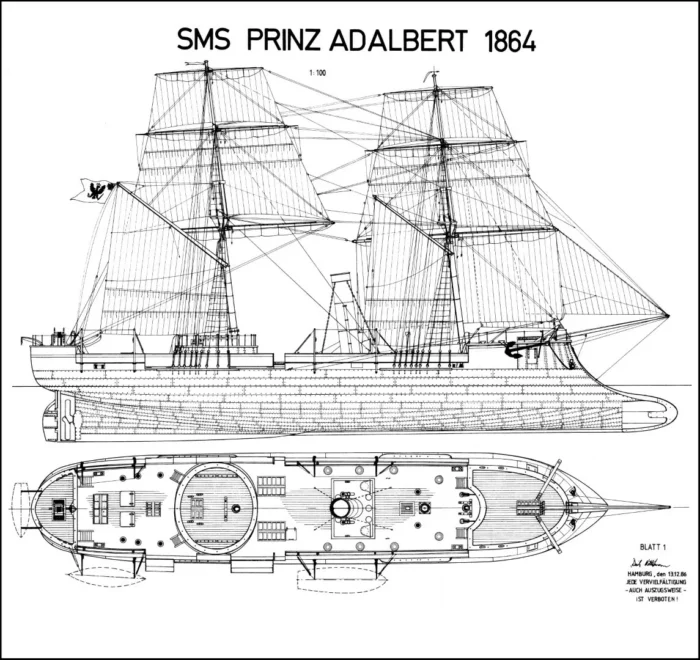
SMS Prinz Adalbert, 1986 reconstructed german plan, from Arman Bros. archives
Protection
Prinz Adalbert was armored with wrought iron, mounted on the wooden hull and secured by rivets. The armored belt protected the waterline and went down to approx. 1.5 meters, being 127 mm (5 inches) thick. The turret aft was protected by 114 mm (4.5 in) of armor plating as well as the forward forecastle casemate. There were three ports forward for the main gun and four ports for the “turret” aft.
Powerplant
Prinz Adalbert was powered by a steam engine provided by Mazeline in Le Havre, Normandy. These were a pair of 2-cylinder single-expansion steam engines in a single engine room. They were fed by the steam coming from two trunk boilers in a single boiler room. They worked at 1.5 standard atmospheres (150 kPa). The shafts turned four-bladed screw propellers 3.6 m (11 ft 10 in) in diameter. Overall she was rated as 1,200 PS (1,184 ihp), enough for a top speed as contracted of 12 knots (22 km/h; 14 mph). In reality she only amde 9.5 knots (17.6 km/h; 10.9 mph) on trials, which was not that great for ramming attacks and caused the yard a penalty and a dispute with Mazeline.
Agility being required as paramount to multiply ramming attemps (the battle of Lissa in 1866 would only confirmed this). So she was fitted with wo rudders fitted side by side to ensure good maneuverability. This was conformed when trialled by the Prussians. On one hand she was a poor seaboat as the massive ram bow caused her to plough heavily even in moderate sea states, causing also a lot of seaspray. However she was as intended, responsive to commands from the helm, with a very tight turning radius. Initially her 740-square-meter (8,000 sq ft) brig sailing rig was to supplement her engines for long crossings, but it was later replaced by a 677-square-meter (7,290 sq ft) topsail schooner rig, much simplified, which needed a smaller crew.
Armament
As built, Prinz Adalbert had a main battery of three rifled 36-pounder muzzle-loading guns: One was placed in a fixed five-port bow casemate, two in a fixed two-port “turret” amidships. The latter was fixed. The guns however had all the same movable pivot mounts, allowing them to fire from the different firing ports (3 positions forward, 2 aft either side).
After delivery in 1865 however the French guns were replaced with Krupp guns of different calibers. A more modern and potent 21 cm RK L/19 gun of 20.95-centimeter (8.25 in) in the bow, two 17 cm RK L/25 of 17.26 cm (6.80 in) in the central battery. The forward gun came out with 76 rounds of ammunition, the central guns 71 shells each.
21 cm RK L/19 gun
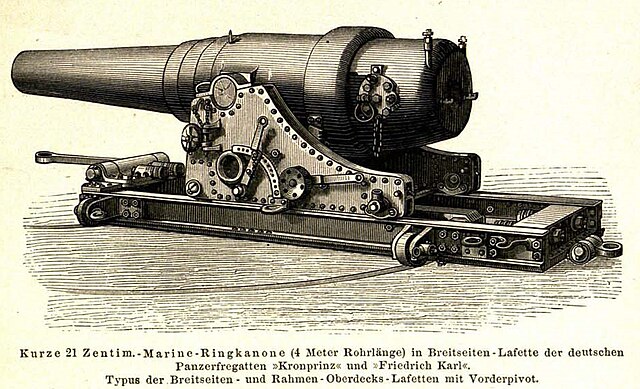
The 21 cm RK L/19 was the later name of a rifled breech loader gun of the Prussian Navy featuring a massive gun barrel cast from steel in one piece. In 1868 it evolved into a built-up gun barrel version. It was known in 1870 as the “kurze Ring Kanone” and later standardized as the “21 cm Ring Kanone L/19.”
Mass: 9,390 kg
Length: 3.923 m L/19
True Caliber: 209.5 mm
Breech: Horizontal sliding breech
Muzzle velocity: 425 m/s
Effective firing range: 3,750 m at 9.5°
17 cm RK L/25
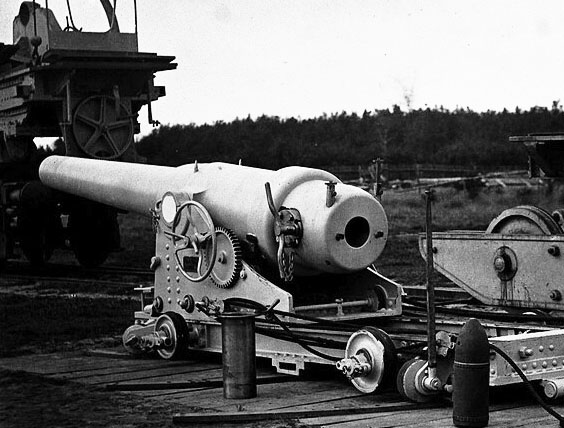
This was a family of German naval artillery guns developed in 1868. It became widespread in the Imperial German Navy, Royal Netherlands Navy, and others.
Mass: 5,600 kg
Length: 4.250 m
Caliber: 172.6 mm
Muzzle velocity: 524 m/s.
⚙ specifications |
|
| Displacement | 1,560 metric tons (1,540 long tons) fully loaded |
| Dimensions | 56.96 x 9.92 x 5.02m (186 ft 11 in x 32 ft 7 in x 16 ft 6 in) |
| Propulsion | 2x single-expansion steam engine, 2 boilers, 1,200 PS (1,184 ihp) |
| Speed | 9.5 knots (17.6 km/h; 10.9 mph) |
| Range | 1,200 nmi (2,200 km; 1,400 mi) at 8 knots (15 km/h; 9.2 mph) |
| Armament | 1× 20.95 cm (8.2 in) gun, 2× 17.26 cm (6.8 in) guns |
| Protection | Belt: 127 mm (5 in), Gun turrets: 114 mm (4.5 in) |
| Crew | 10 officers, 120 enlisted men |
Career of Prinz Adalbert
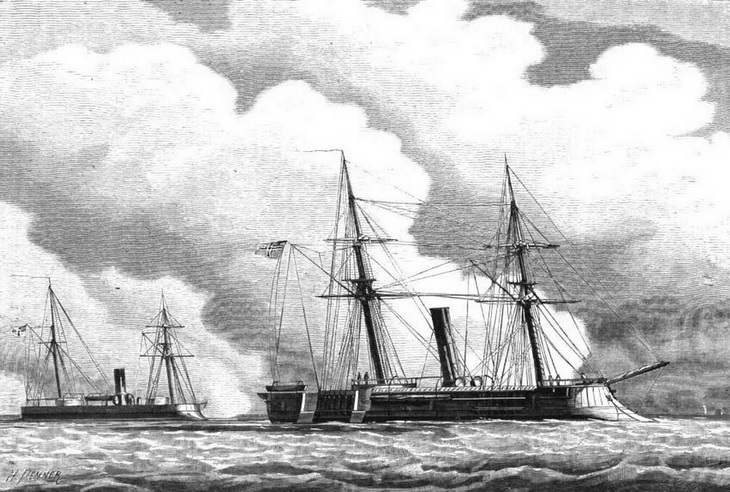
Prinz Adalbert and Arminius sailing together in 1867
Still named Cheops, the future Prinz Adalbet left Bordeaux on 3 May 1866, stopped in Cherbourg, then Gothenburg, Sweden to coal before proceeding to Neufahrwassar in Prussia on 25 May. Her first sea trials revealed she ship handled better than expected, although her ram bow created a very large wave, flooding into her forward gun position. This was of course a real problem given her intended tactic, and was done in the relatively calm waters of the baltic.
She was lightly grounded on 3 June, having minor repairs. She failed however to reach her contract speed of 12 knots (22 km/h; 14 mph), only aachieving 9.5 knots. so Arman accepted a 100,000 francs cut in payment as contracted. She was renamed on 29 October as Prinz Adalbert, one of the creators of the fleet, formally commissioned on 10 June 1866 and at that stage the second ironclad acquired by the Prussian Navy after the turret ship Arminius. The pair formed the core of this burgeoning new, modern fleet completed by scored of steam “corvettes”.
An early hull inspection revealed she was already in poor condition when entering service, while the fleet logistical condition was just learning lessons the hard way. She was commissioned on 10 June under the command of MacLean, but remained ashore for two days until her Prussian captain arrived. The executive officer was not available until 15 June and the sailors had no food when they arrived as well so MacLean made an advance on their pay so that they could find purchased it in town.
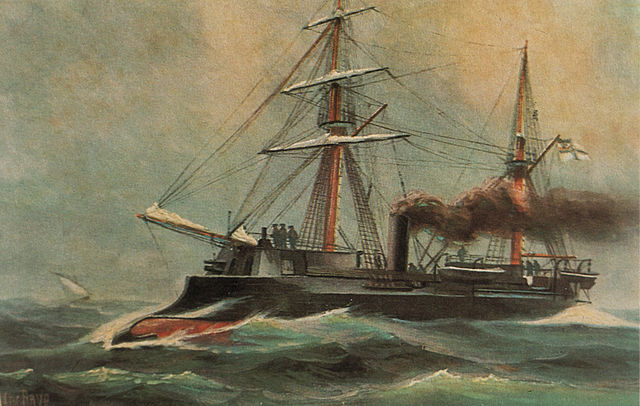
Apart food, sailors just had a single set of uniform to care for. She nevertheless proceeded to open sea on 12 July with a load of munitions borrowed to the fortress at Friedrichsort, Kiel. She sailed then for the rougher North Sea, and as expected, met bad weather which caused severe bow flooding. So much so she had to fold back and seek shelter in Mandal, Norway. Her poor construction due to the green wood started to show her leaking badly as well. When bacl at the Weser drydock for inspection it was revealed her hull seams caulked poorly and had to be redone. It happened just as the Austro-Prussian War flared up.
At the time she was under command of Vizeadmiral (Vice Admiral) Eduard von Jachmann. But naval opposition was nil, and she had no immediate task, neither in the North and Baltic Seas. Due to her general bad condition she stayed in port during the war.
Other inspections revealed a long list of defects, many in her construction, armor plate, gaps between armor and hull timbers, as well as galvanic corrosion between the iron armor and copper sheathing below the waterline, which was even a more pressing issue as she could sank at any moment notice. Her sailing rig was also borrly managed and almost unusable. But the greatest underlying issue was her low-quality, green wood used for her construction which needed replacement. Waiting to fund this complete refurbishment, she was decommissioned on 25 October 1868 at the naval depot at Geestemünde. She was still her by late 1869. Her armor plating was removed to access the wooden hull and replace all beams. To avoid ram bow flooding issues she obtained a breakwater at the stern the main mast was relocated further aft and she was re-rigged as a schooner.
Meanwhile, a London-based company approached Prussia to purchase her for the Greek Navy and Jachmann approved it, until the Admiralty intervened and blocked the same. Prinz Adalbert saw eventually the completion of her refit but continued to suffer from severe leaking for the remainder of her career while being a poor sailing vessel due to her massive bow.
She was recommissioned indeed on 14 April 1869 but at that stage she was reassigned as guard ship in the lower Elbe, so anchored and presumably not forced to sail anywhere. She was stationed in Altona at first. There, she was visited frequently by citizens of Hamburg.
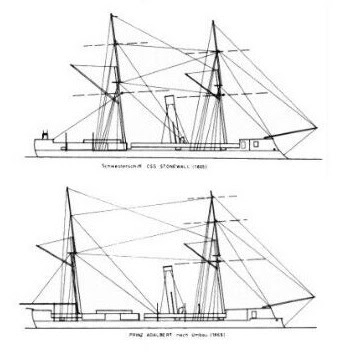 On 19 June, she sailed to the site in construction that would become Wilhelmshaven, for a ceremony marking the start of its construction. In May 1870, Prinz Adalbert joined the three armored frigates Friedrich Carl, Kronprinz, and König Wilhelm for a state visit to Britain. Friedrich Carl ran aground and went back to Kiel for repairs. The remaining thre armoured ships entered Plymouth and were soon joined by Friedrich Carl after short repairs. On 1 July they made their first Atlantic training cruise to Fayal, Azores. Tensions flaring however with France over the Hohenzollern candidacy made this cruise dangerous as they could be blockade on their way back by France in the English Channel in case of war. Prinz Adalbert was sent back to Dartmouth for more informeations, the rest resumed their cruise and arrived in turn on 13 July. As war was now imminent, they were ordered to return home. Kronprinz took Prinz Adalbert under tow however due to her slow speed.
On 19 June, she sailed to the site in construction that would become Wilhelmshaven, for a ceremony marking the start of its construction. In May 1870, Prinz Adalbert joined the three armored frigates Friedrich Carl, Kronprinz, and König Wilhelm for a state visit to Britain. Friedrich Carl ran aground and went back to Kiel for repairs. The remaining thre armoured ships entered Plymouth and were soon joined by Friedrich Carl after short repairs. On 1 July they made their first Atlantic training cruise to Fayal, Azores. Tensions flaring however with France over the Hohenzollern candidacy made this cruise dangerous as they could be blockade on their way back by France in the English Channel in case of war. Prinz Adalbert was sent back to Dartmouth for more informeations, the rest resumed their cruise and arrived in turn on 13 July. As war was now imminent, they were ordered to return home. Kronprinz took Prinz Adalbert under tow however due to her slow speed.
The flotilla made it unto Wilhelmshaven on 16 July, just three days before France declared war on Prussia after the Ems Dispatch. In the coming Franco-Prussian War of 1870–1871, the Prussian Navy was found wodefully unprepared and under a greatly numerically inferiority. There was no choice assume a defensive posture against a naval blockade. Bismarck however was fully confident of his armies’s rapid success. Prinz Adalbert became a harbor guard ship in Hamburg, used as command ship also for four gunboats, seven torpedo boats using spar torpedoes. In July KL Friedrich von Hacke took command. She made a few sorties into the North Sea to try to locate French warships but the French blockade proved almost impossible to setup due to poor logistics.
After the war ended, Prinz Adalbert was reassigned as a guard ship in the Elbe. But she was still leaking badly. Her pumps were run constantly. A new inspection of her timber hull in 1871 showed the whole structure was now completely rotten. Unsatisfied with her from the start, the admirakty thus decided to have her decommissioned on 28 October. In between she passed from the Prussian to the Kaiserliche Marine (Imperial Navy). It was still considered to keep her as a training ship for engine room crews but her now outdated machinery was not useful for her task. She was thus removed from service for good on 23 October 1871, disarmed in 1875–1876 then formally stricken on 28 May 1878 and broken up in Wilhelmshaven, engines and armor plate reused.
Read More/Src
Books
Dodson, Aidan (2016). The Kaiser’s Battlefleet: German Capital Ships 1871–1918. Barnsley: Seaforth Publishing. ISBN 978-1-84832-229-5.
Greene, Jack & Massignani, Alessandro (1998). Ironclads at War: The Origin and Development of the Armored Warship, 1854–1891. Pennsylvania: Combined Publishing. ISBN 978-0-938289-58-6.
Gröner, Erich (1990). German Warships: 1815–1945. Vol. I: Major Surface Vessels. Annapolis: Naval Institute Press. ISBN 978-0-87021-790-6.
Hildebrand, Hans H.; Röhr, Albert & Steinmetz, Hans-Otto (1993). Die Deutschen Kriegsschiffe: Biographien – ein Spiegel der Marinegeschichte von 1815 bis zur Gegenwart [The German Warships: Biographies − A Reflection of Naval History from 1815 to the Present] (in German). Vol. 7. Ratingen: Mundus Verlag. ISBN 978-3-7822-0267-1.
Sondhaus, Lawrence (2001). Naval Warfare, 1815–1914. London: Routledge. ISBN 978-0-415-21478-0.
Sondhaus, Lawrence (1997). Preparing for Weltpolitik: German Sea Power Before the Tirpitz Era. Annapolis: Naval Institute Press. ISBN 978-1-55750-745-7.
Sullivan, David M. (1987). “Phantom Fleet: The Confederacy’s Unclaimed European Warships”. Warship International. XXIV (1). Toledo: International Naval Research Organization: 13–32. ISSN 0043-0374.
Links
imm-hamburg.de museum sms prinz adalbert exhibit
en.wikipedia.org SMS_Prinz_Adalbert_(1865)
de.wikipedia.org/ Prinz_Adalbert_(Schiff_1865)
www.history.navy.mil/ /NH-93839.html
on facebook.com/
deutsche-schutzgebiete.de
navalhistory.flixco.info
/seawarpeace.ru/
Videos
nope
Model Kits
Stonewall/Kotetsu as a base to start with

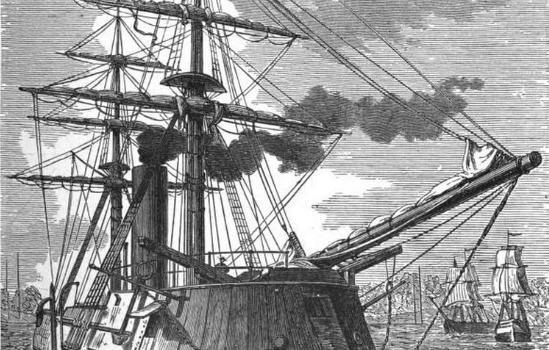
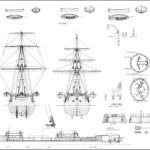
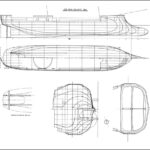
 Latest Facebook Entry -
Latest Facebook Entry -  X(Tweeter) Naval Encyclopedia's deck archive
X(Tweeter) Naval Encyclopedia's deck archive Instagram (@navalencyc)
Instagram (@navalencyc)





 French Navy
French Navy Royal Navy
Royal Navy Russian Navy
Russian Navy Armada Espanola
Armada Espanola Austrian Navy
Austrian Navy K.u.K. Kriegsmarine
K.u.K. Kriegsmarine Dansk Marine
Dansk Marine Nautiko Hellenon
Nautiko Hellenon Koninklije Marine 1870
Koninklije Marine 1870 Marinha do Brasil
Marinha do Brasil Osmanlı Donanması
Osmanlı Donanması Marina Do Peru
Marina Do Peru Marinha do Portugal
Marinha do Portugal Regia Marina 1870
Regia Marina 1870 Nihhon Kaigun 1870
Nihhon Kaigun 1870 Preußische Marine 1870
Preußische Marine 1870 Russkiy Flot 1870
Russkiy Flot 1870 Svenska marinen
Svenska marinen Søværnet
Søværnet Union Navy
Union Navy Confederate Navy
Confederate Navy Armada de Argentina
Armada de Argentina Imperial Chinese Navy
Imperial Chinese Navy Marinha do Portugal
Marinha do Portugal Mexico
Mexico Kaiserliche Marine
Kaiserliche Marine 1898 US Navy
1898 US Navy Sovietskiy Flot
Sovietskiy Flot Royal Canadian Navy
Royal Canadian Navy Royal Australian Navy
Royal Australian Navy RNZN Fleet
RNZN Fleet Chinese Navy 1937
Chinese Navy 1937 Kriegsmarine
Kriegsmarine Chilean Navy
Chilean Navy Danish Navy
Danish Navy Finnish Navy
Finnish Navy Hellenic Navy
Hellenic Navy Polish Navy
Polish Navy Romanian Navy
Romanian Navy Turkish Navy
Turkish Navy Royal Yugoslav Navy
Royal Yugoslav Navy Royal Thai Navy
Royal Thai Navy Minor Navies
Minor Navies Albania
Albania Austria
Austria Belgium
Belgium Columbia
Columbia Costa Rica
Costa Rica Cuba
Cuba Czechoslovakia
Czechoslovakia Dominican Republic
Dominican Republic Haiti
Haiti Hungary
Hungary Honduras
Honduras Estonia
Estonia Iceland
Iceland Eire
Eire Equador
Equador Iran
Iran Iraq
Iraq Latvia
Latvia Liberia
Liberia Lithuania
Lithuania Mandchukuo
Mandchukuo Morocco
Morocco Nicaragua
Nicaragua Persia
Persia San Salvador
San Salvador Sarawak
Sarawak Uruguay
Uruguay Venezuela
Venezuela Zanzibar
Zanzibar Warsaw Pact Navies
Warsaw Pact Navies Bulgaria
Bulgaria Hungary
Hungary

 Bundesmarine
Bundesmarine Dutch Navy
Dutch Navy Hellenic Navy
Hellenic Navy Marina Militare
Marina Militare Yugoslav Navy
Yugoslav Navy Chinese Navy
Chinese Navy Indian Navy
Indian Navy Indonesian Navy
Indonesian Navy JMSDF
JMSDF North Korean Navy
North Korean Navy Pakistani Navy
Pakistani Navy Philippines Navy
Philippines Navy ROKN
ROKN Rep. of Singapore Navy
Rep. of Singapore Navy Taiwanese Navy
Taiwanese Navy IDF Navy
IDF Navy Saudi Navy
Saudi Navy Royal New Zealand Navy
Royal New Zealand Navy Egyptian Navy
Egyptian Navy South African Navy
South African Navy






























 Ukrainian Navy
Ukrainian Navy dbodesign
dbodesign